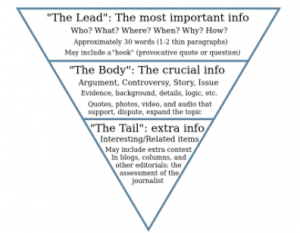News writing
Text
News is always written using an inverted pyramid structure and the 5Ws.

A news story gives it all away in the first paragraph called the “lead”. Here everything is revealed, and the following paragraphs, called the “body”, follow to explain what was in this first paragraph.
The 5 Ws is the essential information contained in the story: what, where, when, who and why. Without this basic information, the story you are telling is not understandable.
It’s always necessary to identify an angle for your story. What basically are you trying to say through the story? This is important because with the limited space you have to tell the story, getting the story angle right will guide the writing of it and it will inform the first paragraph. An event or incident has many angles; selecting the right one for the news item is the real skill of the journalist.
You should also provide a headline for your news item. This will summarise in as few words as possible the angle of the story. It is used hook in the reader to read the story.
A photograph to accompany a text news story is a good idea. It gives readers a picture of the event or incident location, or of the people involved in the news story. For copyright reasons, always take your own photos.
News writing adopts an active voice, which means subject verb object. The actor in the story always comes first in the sentence.
Use brief quotes from the actors because they enrich a news story.
Photographs
When telling a news story through photographs, you need to provide a heading (which is a summary of the story’s angle) and a caption to each photograph. This short caption uses the 5Ws: what, where, when, who and why.
Audio
You will always write a script for your audio news story. The script will follow the same principles as for text: the inverted pyramid and 5Ws. The lead paragraph will contain the 5Ws: what, where, when, who and why.
A ‘grab’ refers to other voices that have been recorded for the news items, and they must be always identified in the script as who they are and the position they hold.
When spoken, it takes about 100 words / minute to read a script.
Transpose the audio grabs and incorporate them into your script so they don’t something you have already said.
Pronunciation of some name and words may be difficult, so check them out and write them in the script how you would say them.
Audio scripts are often written with spaces for pauses, and underlines or bold for stress.
Always read the script out loud before recording it: you may need to alter the structure of a sentence because it was difficult to voice.
Video
The scripts for Video news follow the same processes as for audio, although the video grabs will be inserted without an audio introduction. Instead they will be captioned on screen at a later stage in the editing. In the script, though, it’s necessary to provide the details of the person – name, organisation – who’s making the comment.
For more on News Writing, read the Community Training Media Organisation Manual.
